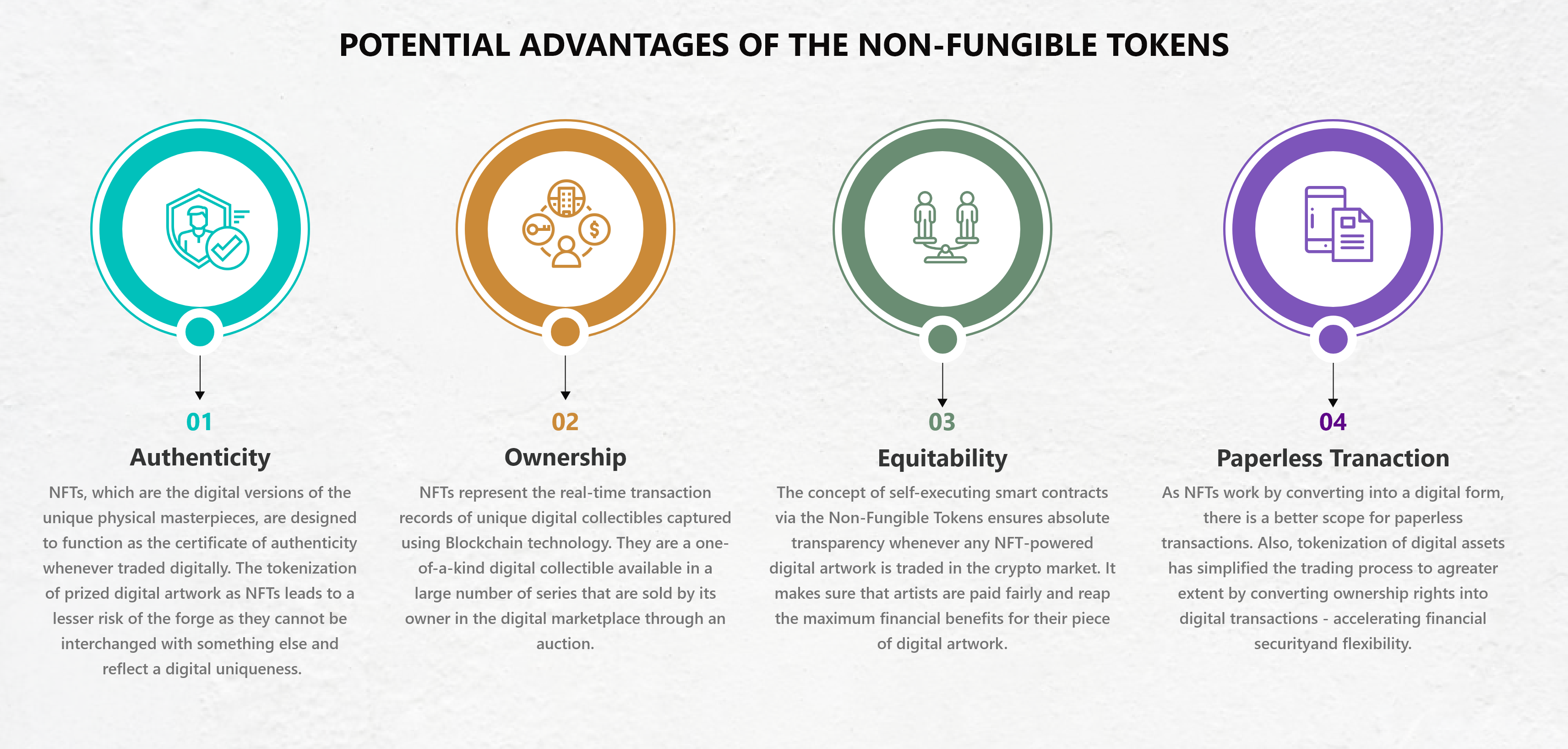Other recent blogs
Let's talk
Reach out, we'd love to hear from you!
Having covered aspects of Decoding NFT - The Pulse of Digital Assets in Part 1 and a detailed guide on NFT Marketplace Development in part 2, we now look at the future of Non-Fungible Tokens: 2022 and beyond in the part 3 of NFT blog series.
The ever-increasing penetration of Non-Fungible Tokens (aka NFTs) has proven immensely beneficial for digital artists, enabling them to break through traditional norms and granting more economic power to them. By democratizing the art industry, NFTs mark a new chapter for digital commerce amidst the ongoing pandemic, and this trend of technological capitalism seems to be long-lasting.
The real concept of NFTs has been in existence with us since December 2012, when “Colored Coins” was launched by Vitalik Buterin, the creator of Ethereum. Later, the emergence of Non-Fungible Tokens was reflected in the conception of Etheria (in 2015), CryptoKitties (in 2017), and Cryptopunks (in 2017). These are some real NFT projects that marked the first turning point in the history of “NFTs” or the Non-Fungible Token. Fast forward to now, the NFTs Marketplaces have grown into a multibillion-dollar industry with more than $2 billion sales in the first quarter of 2021 and still growing.
One of the primary reasons why the NFT trend is so dominating is that privatization of gain is followed by digital scarcity. The Non-Fungible Tokens hold the awesomeness of Blockchain Technology to certify the provenance, authenticity, and ownership of digital masterpieces. Not only are they reflecting the Blockchain’s latest manifestation of value, but NFTs are reshaping the future of virtual art galleries by removing gatekeepers. This way, NFTs are pushing the concept of democratization and digital scarcity for unique digital collectibles while unlocking growth possibilities for digital artists.
But, the million-dollar question is what does the future of NFT-commerce look like? Will NFTs go up in value?
NFTs look transformational for the future of digital trading, and there is no sign of slow down.
With the sale of $6 Million in just one month as of April 2021, the Non-Fungible Tokens are undoubtedly experiencing exponential growth and reflecting another facet of the recent crypto boom in the already volatile cryptocurrency market. And here is why NFTs have exploded in popularity and how NFTs benefit digital artists.
Potential advantages of the Non-Fungible Tokens
Let’s delve deeper into the potential advantages of the Non-Fungible Tokens:

The reality hits of NFTs
Like any other quickly evolving technology that offers innovative opportunities to individuals, the Non-Fungible Tokens have some significant challenges, potential risks, and reality hits that need to be tackled immediately. Given below are some barriers to successful NFTs adoption:

- Authenticity: NFTs, which are the digital versions of the unique physical masterpieces, are designed to function as the certificate of authenticity whenever traded digitally. The tokenization of prized digital artwork as NFTs leads to a lesser risk of the forge as they cannot be interchanged with something else and reflect a digital uniqueness.
- Ownership: NFTs represent the real-time transaction records of unique digital collectibles captured using Blockchain technology. They are a one-of-a-kind digital collectible available in a large number of series that are sold by its owner in the digital marketplace through an auction.
- Accessibility: NFTs are limited, indivisible, easy to transfer, and exclusive tokens that any individual can access by opening an Ethereum wallet with minimum entry barriers. This highly publicized convergence of digital art and crypto tokens bringing artists the highest level of accessibility through a secured network where artists tokenize their digital works as NFTs for sale. With the built-in smart contracts in the form of NFTs, the traditional intermediaries like auctions houses or galleries are pushed out from the circle, giving complete control to artists to trade their artworks directly to the buyers. NFTs enable the democratization of artwork.
- Equitability: The concept of self-executing smart contracts via the Non-Fungible Tokens ensures absolute transparency whenever any NFT-powered digital artwork is traded in the crypto market. It makes sure that artists are paid fairly and reap the maximum financial benefits for their piece of digital artwork.
- Paperless Transaction: As NFTs work by converting into a digital form, there is a better scope for paperless transactions. Also, tokenization of digital assets has simplified the trading process to a greater extent by converting ownership rights into digital transactions - accelerating financial security and flexibility.
Cost and Sustainability: To generate the Non-Fungible Tokens, the Blockchain development company uses the blockchain technology, which is a relatively expensive and complex procedure. Furthermore, the process of NFT mining is energy-intensive and cannot be considered sustainable in the long run.
Lack of buyers: It has been found in many reports that the NFT marketplaces are quite concentrated and have a significantly less number of buyers. NFTs are yet to see mainstream adoption across many countries.
Gas fees: It is one of the major roadblocks for many artists keen to adopt NFTs. Gas fees can be explained as a specific amount of outrageous upfront fee every creator must pay to mint an NFT.
Energy consumption: The environmental impact created by NFTs is indeed a hot topic of discussion. The process of mining and trading cryptocurrencies like NFTs involves massive amounts of electricity, and to minimize an ecological collapse, we need to shift NFT platforms to a new system that would consume less energy.
Explore more in the NFT blog series:
Part 1: Decoding NFT - The Pulse of Digital Assets where you will learn how Non-Fungible tokens pushing digital frontiers for Top Blockchain Development Company and accelerating digital transformation for businesses.
Part 2: A Detailed Guide on NFT Marketplace where everything is explained about why the Blockchain-based NFT Marketplaces are the most significant breakthrough and why they are expected to change the world.






